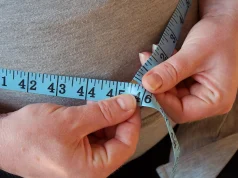Clinically important false-negative rate for self-measured waist circumference
THURSDAY, May 19, 2016 (HealthDay News) — Self-measured waist circumference has a clinically important false-negative rate compared with professionally-measured waist circumference, according to a study published in the May/June issue of the Annals of Family Medicine.
Barbara G. Carranza Leon, M.D., from the Mayo Clinic in Rochester, Minn., and colleagues investigated whether self-measured waist circumference is sufficiently accurate to replace professionally-measured waist circumference. Waist circumference was self-measured at the same visit during which a professionally-measured waist circumference was obtained among 585 women and 165 men.
The researchers observed no significant difference in self- and professionally-measured waist circumference but there was a clinically important false-negative rate for the self-measurements. Based on professionally-measured waist circumference, 11 and 52 percent of normal weight and overweight women, respectively, were in a high-risk category for metabolic syndrome; 57 and 18 percent of these women, respectively, undermeasured their own waist circumference and fell below the cut-off. Among men, 15 and 84 percent of overweight and class I obese, respectively, had a professionally-measured waist circumference putting them in the high-risk category; 23 and 16 percent, respectively, undermeasured their waist circumference.
“Despite standardized pictorial instructions for self-measured waist circumference, the false-negative rate of self-measurements approached or exceeded 20 percent for some groups at high risk for poor health outcomes,” the authors write.
Copyright © 2016 HealthDay. All rights reserved.








